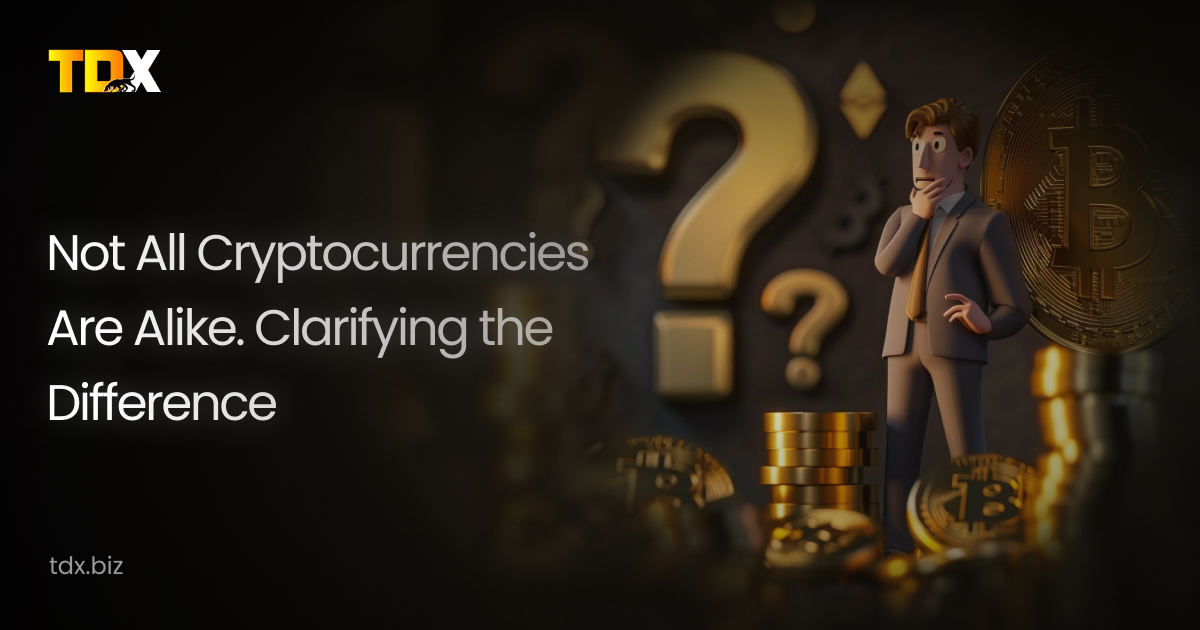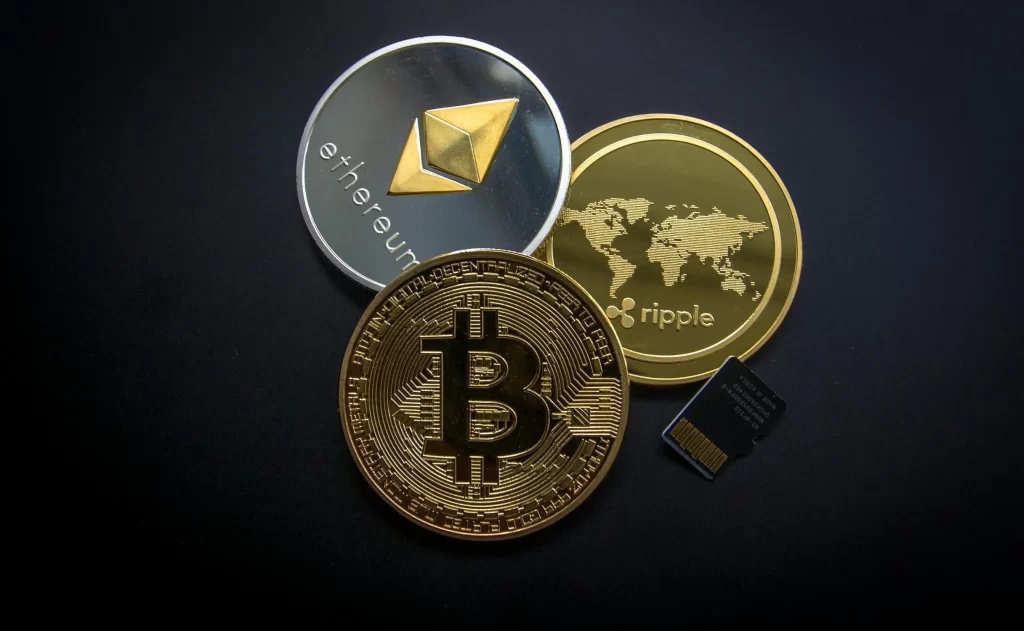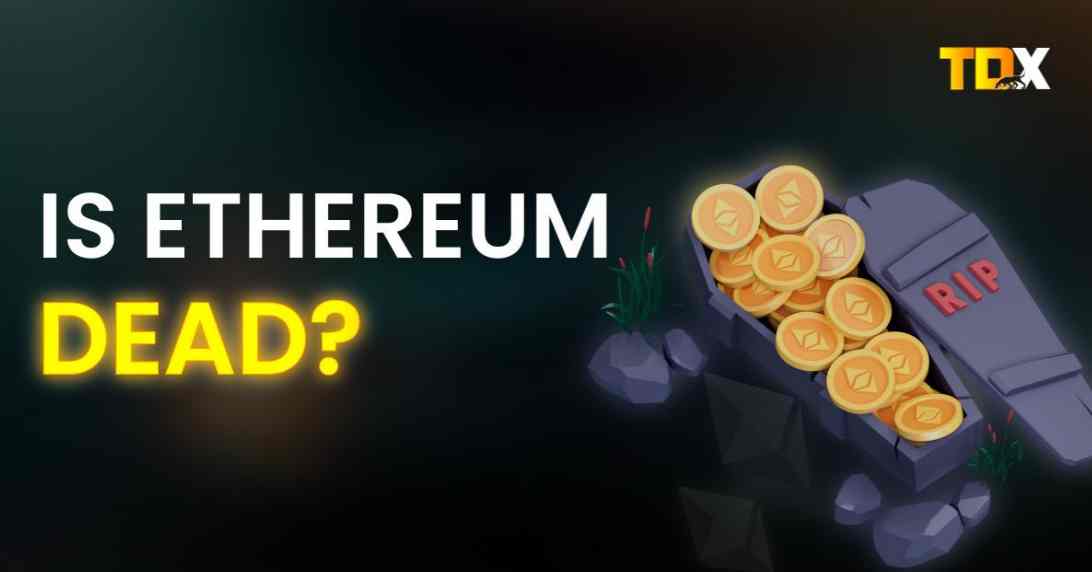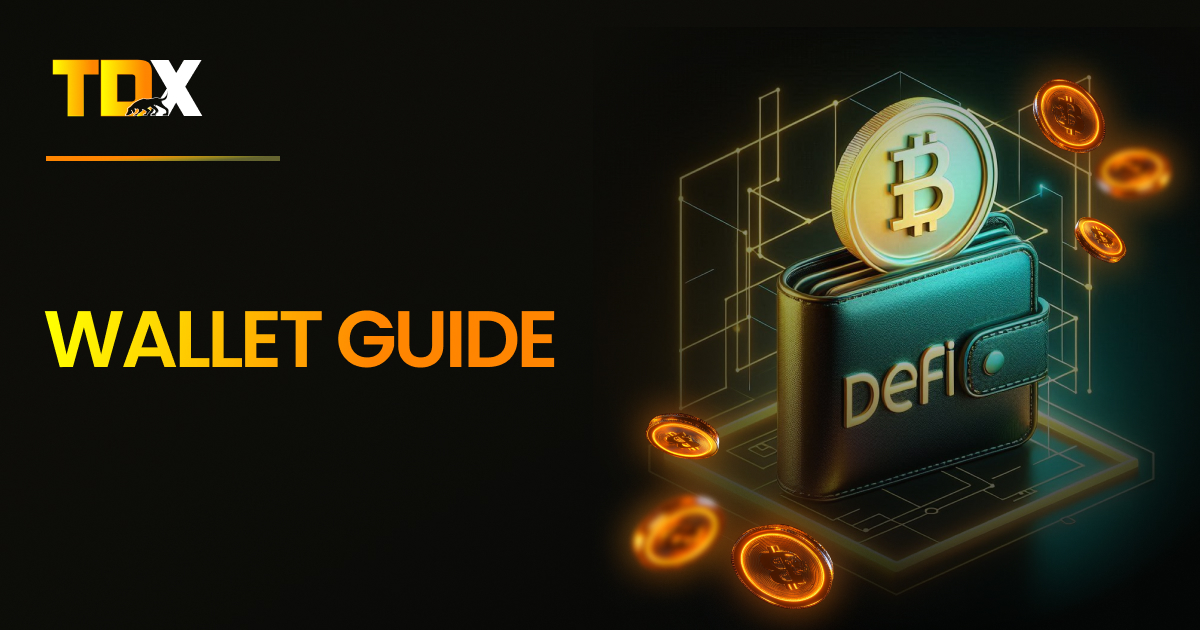 Back to blog
Back to blog


Not All Cryptocurrencies Are Alike: Clarifying the Difference
Cryptocurrencies have taken the financial world by storm, offering revolutionary changes to how we think about money, transactions, and the very fabric of our economic systems. From Bitcoin to a plethora of so many different altcoins, each crypto has its own unique attributes and purposes.
Understanding these differences is crucial for anyone looking to invest, use, or simply comprehend the evolving landscape of digital currencies. This article aims to dissect the various types of cryptocurrencies, their key features, and what sets them apart from one another.
Cryptocurrencies are not uniform. They range from established ones like Bitcoin to newer entrants like meme coins. For instance, Shiba Inu (SHIB), Dogecoin (DOGE), and many others have garnered substantial attention in 2024, driven by social media hype and community engagement. These meme coins have seen surges in popularity, partly due to endorsements from high-profile figures and the viral nature of online platforms. Understanding the nuances among them can provide clarity for investors and enthusiasts alike.
So, let’s explore what makes each type of cryptocurrency unique and understand their differences. Read on!

Types of Cryptocurrencies
Bitcoin (BTC)
Bitcoin, often referred to as the “king of cryptocurrencies,” was the first digital currency to gain mainstream recognition. Introduced in 2009 by an anonymous entity known as Satoshi Nakamoto, Bitcoin was designed to offer a decentralized alternative to traditional fiat currencies.
Key Features and Purpose
Bitcoin operates on a peer-to-peer network powered by blockchain technology, ensuring transparency and security. Its primary use case is to serve as a store of value and medium of exchange, akin to “digital gold.” The total supply of Bitcoin is capped at 21 million, adding to its scarcity and attractiveness as an investment.
The blockchain ledger records all transactions, making them transparent and immutable. This trustless system removes the need for intermediaries like banks, reducing transaction costs and increasing efficiency. Bitcoin’s decentralized nature means no single entity controls it, which is a stark contrast to traditional currencies managed by central banks. This decentralization is a double-edged sword: while it offers freedom from governmental control, it also means that Bitcoin is highly volatile and influenced by market sentiment.
Use Cases and Adoption
Bitcoin is widely accepted for various transactional purposes, from purchasing goods and services to acting as a hedge against inflation. Major companies like Tesla and PayPal have integrated Bitcoin into their payment systems, further solidifying its role in the global economy. Additionally, Bitcoin ATMs are becoming more prevalent, making it easier for people to buy and sell Bitcoin.
Its role as a hedge against inflation is particularly noteworthy in countries experiencing economic turmoil. For instance, in places like Venezuela or Zimbabwe, where hyperinflation has devastated local currencies, Bitcoin offers a more stable alternative.
Moreover, Bitcoin is increasingly being used in international remittances. Traditional remittance services charge high fees and take days to process transactions. Bitcoin, on the other hand, allows for near-instant transfers at a fraction of the cost.
Altcoins
Definition and Examples
Altcoins, or alternative coins, are any cryptocurrencies other than Bitcoin. They were developed to address some of the perceived limitations of Bitcoin and to introduce new functionalities.
Differences from Bitcoin
While Bitcoin primarily aims to serve as a digital currency, many altcoins have broader use cases, such as enabling smart contracts, improving transaction speeds, or focusing on privacy.
Popular Altcoins: Ethereum (ETH), Ripple (XRP), Litecoin (LTC)
- Ethereum (ETH)
Known for its smart contract functionality, Ethereum enables developers to create decentralized applications (dApps) on its platform. It has spawned an entire ecosystem of projects and tokens.
Ethereum’s blockchain is programmable, meaning it can execute code through smart contracts. These smart contracts are self-executing contracts with the terms directly written into lines of code. They run automatically when predefined conditions are met, eliminating the need for intermediaries and reducing the risk of fraud. This innovation has led to the development of decentralized finance (DeFi) platforms, non-fungible tokens (NFTs), and more.
- Ripple (XRP)
Designed to facilitate real-time, cross-border payments, Ripple aims to improve the current banking system’s inefficiencies.
Ripple’s technology connects different financial institutions, allowing them to transfer money across borders quickly and efficiently. Traditional cross-border payments can take days and incur high fees due to intermediary banks. Ripple’s network significantly reduces these delays and costs. Banks and financial institutions using Ripple’s platform can settle transactions in seconds.
- Litecoin (LTC)
Often referred to as the silver to Bitcoin’s gold, Litecoin offers faster transaction times and lower fees.
Litecoin was created by Charlie Lee in 2011 as a lighter version of Bitcoin. It uses a different hashing algorithm (Scrypt) and has a block generation time of 2.5 minutes compared to Bitcoin’s 10 minutes. It makes Litecoin faster for everyday transactions.
Stablecoins
What Are Stablecoins?
Stablecoins are a category of cryptocurrencies designed to minimize price volatility. They achieve this by pegging their value to a reserve asset, such as the US dollar or gold.
Purpose and Function
Stablecoins aim to combine the benefits of cryptocurrency—such as speed and security—with the stability of traditional fiat currencies. They are often used for trading, as a store of value, and for remittances.
Stablecoins bridge the gap between volatile cryptocurrencies and stable fiat currencies. They provide a safe haven during market downturns and offer a reliable medium of exchange and unit of account in the crypto world. Traders often use stablecoins to park their funds during high volatility periods without exiting the cryptocurrency market entirely.

Tether (USDT), USD Coin (USDC)
- Tether (USDT)
One of the most widely used stablecoins, Tether is pegged to the US dollar on a 1:1 basis. It is commonly used for trading and transferring funds between exchanges.
USDT maintains its peg by holding reserves equal to or greater than the amount of Tether in circulation. Despite controversies over its transparency and reserve claims, Tether remains the most traded cryptocurrency by volume.
- USD Coin (USDC)
Another popular stablecoin, USDC is fully backed by US dollar reserves and audited regularly to ensure transparency.
USDC operates under a more transparent model, with regular audits to confirm that each USDC is backed by a dollar. It is used extensively in the DeFi ecosystem and has gained trust due to its regulatory compliance.
Utility Tokens
Definition and Role in the Ecosystem
Utility tokens are digital assets that provide access to a specific product or service within a blockchain ecosystem. Unlike security tokens, they do not represent an ownership stake in a company.
Use Cases in Decentralized Applications (dApps)
Utility tokens are essential for the functioning of decentralized platforms, enabling users to access various services, pay for transactions, or participate in governance processes.
These tokens incentivize participation and usage within their respective ecosystems. For instance, in the case of a decentralized storage platform, users might pay with utility tokens to store their data. Miners or validators who provide storage space are rewarded with these tokens.
Binance Coin (BNB), Chainlink (LINK)
- Binance Coin (BNB)
Originally launched as an ERC-20 token on the Ethereum blockchain, BNB is now the native currency of the Binance Chain. It is used to pay for transaction fees on the Binance Exchange and participate in token sales.
BNB offers multiple utilities within the Binance ecosystem. Users can pay for trading fees with BNB at a discounted rate. It’s also used in the Binance Launchpad for participating in new token sales (Initial Exchange Offerings).
- Chainlink (LINK)
LINK is used to pay for services within the Chainlink network, a decentralized oracle service that connects smart contracts with real-world data.
Chainlink provides secure and reliable oracles to fetch external data for smart contracts. For example, it can pull weather data for an insurance smart contract that pays farmers based on rainfall levels. LINK tokens are used to pay node operators for providing these data services.
Security Tokens
Explanation of Security Tokens
Security tokens are digital assets that represent ownership in an underlying asset, such as shares in a company, real estate, or other investment vehicles. They are subject to federal securities regulations.
Regulatory Implications
Because security tokens are considered securities, they must comply with regulatory standards set by agencies like the SEC. This adds a layer of trust and protection for investors but also imposes compliance costs.
Issuing security tokens involves rigorous due diligence, disclosure requirements, and adherence to Know Your Customer (KYC) and Anti-Money Laundering (AML) regulations. This compliance ensures that only legitimate investors participate.
Examples and Benefits
Security tokens offer fractional ownership, increased liquidity, and the potential for 24/7 trading. Examples include tokens representing real estate shares, equity in startups, and more.
One notable example is the tokenization of real estate. By issuing security tokens, property owners can sell fractions of their property to multiple investors. This democratizes access to high-value assets and provides liquidity to traditionally illiquid markets. Security tokens can also enable faster settlement times and reduced transaction costs compared to traditional securities.
Meme Coins
What Are Meme Coins?
Meme coins are a subcategory of cryptocurrencies that originated as internet jokes or memes but have gained substantial popularity and market value.
Dogecoin (DOGE), Shiba Inu (SHIB)
- Dogecoin (DOGE)
Initially created as a parody of Bitcoin, Dogecoin has grown into a widely recognized token, thanks in part to endorsements from celebrities like Elon Musk.
Dogecoin’s Shiba Inu mascot and playful community have made it a favorite among retail investors. Despite its humorous origins, Dogecoin boasts low transaction fees and a fast block time, making it suitable for microtransactions and tipping.
- Shiba Inu (SHIB)
Dubbed the “Dogecoin killer,” Shiba Inu has built a large community and offers decentralized exchange services.
Shiba Inu has created an ecosystem that includes a decentralized exchange called ShibaSwap, which supports trading, staking, and liquidity provision. The project also launched additional tokens such as LEASH and BONE to complement its primary token, SHIB. The strong community backing and extensive marketing campaigns have driven its popularity.
Speculative Nature and Community Influence
Meme coins are highly volatile and driven largely by community sentiment and social media trends. While they can offer significant returns, they also come with high risks.
The value of meme coins often depends more on viral popularity than on their technological innovations or real-world utility. Social media platforms like Reddit and Twitter play pivotal roles in driving the prices of these coins up or down. This speculative nature means investors must be cautious, as rapid price swings can lead to substantial gains or severe losses within short periods.

Key Differentiators
Purpose and Use Cases
The primary factor that sets different cryptocurrencies apart is their intended purpose and use cases. Bitcoin is primarily a store of value and medium of exchange, while Ethereum focuses on enabling smart contracts and decentralized applications. Stablecoins seek to offer stability, whereas utility tokens provide access to specific services within a blockchain ecosystem.
Understanding the specific use cases helps in making informed investment decisions. For instance, if one is interested in decentralized finance (DeFi), then investing in Ethereum or DeFi-focused altcoins could be beneficial. On the other hand, if one seeks stability amidst market volatility, stablecoins like USDT or USDC would be preferable.
Technology and Protocols
Another crucial differentiator is the underlying technology and protocols. Bitcoin uses a Proof of Work (PoW) consensus mechanism, which requires significant computational power and energy consumption. In contrast, many newer cryptocurrencies like Ethereum are transitioning to Proof of Stake (PoS), which is more energy-efficient. Some altcoins, like IOTA, use Directed Acyclic Graph (DAG) technology instead of traditional blockchain structures, aiming for faster and more scalable transactions.
Technological advancements impact a cryptocurrency’s scalability, security, and transaction speed. For example, PoS aims to address the environmental concerns associated with PoW by reducing energy consumption and improving scalability. Technologies like DAG or Sharding (used in some newer blockchains) aim to improve transaction throughput to handle more users and transactions efficiently.
Market Capitalization and Liquidity
Market capitalization and liquidity are important metrics for assessing a cryptocurrency’s maturity and stability. Bitcoin remains the largest cryptocurrency by market cap, followed by Ethereum. High market cap and liquidity generally indicate a more stable and widely accepted cryptocurrency, reducing the risk of large price swings and making it easier to buy and sell.
Higher market cap cryptocurrencies tend to have lower volatility compared to smaller, lesser-known coins. Liquidity ensures that there are enough buyers and sellers in the market, allowing for smooth transactions without significant price changes. It is crucial for traders who need to enter and exit positions quickly without affecting the market price.
Regulatory Environment
The regulatory environment varies significantly across different countries and can greatly impact the adoption and legality of cryptocurrencies. For example, countries like Japan and Switzerland have embraced cryptocurrencies and implemented clear regulations, while others like China have imposed strict bans. Compliance with regulations is particularly crucial for security tokens, which must adhere to securities laws.
Regulatory clarity can enhance investor confidence and protect against fraud and malpractices. As governments worldwide develop their regulatory frameworks, cryptocurrencies that comply with these regulations will likely see greater adoption and integration into mainstream financial systems.
Conclusion
The world of cryptocurrencies is diverse and constantly evolving. From Bitcoin’s pioneering role to the myriad of altcoins, stablecoins, utility tokens, security tokens, and even meme coins, each type of cryptocurrency serves a distinct purpose and offers unique benefits. Understanding these differences is essential for making informed decisions, whether you’re an investor, developer, or simply an enthusiast. As the market continues to grow and regulatory frameworks develop, staying informed will be key to navigating this exciting and dynamic landscape.
While Bitcoin may reign supreme as the so-called original cryptocurrency, the vast array of alternatives offers specialized solutions catering to various needs within the digital economy. By understanding what distinguishes these different cryptocurrencies — be it their technology, use cases, or regulatory status — one can better appreciate the intricate and multifaceted world of digital assets.
40,000 readers 🚀 are getting insights with our media
 Read on Medium
Read on Medium 

Article
“Is Ethereum dead?” This is a trending argument that is appearing in various crypto communities and media. Which is not…


Guide
Welcome to the beginner’s guide on Trust Wallet, MetaMask, and Exodus—three most common cryptocurrency wallets for managing your crypto assets….


Article
When Venezuela’s inflation hit 189.8% in 2023 [Central Bank of Venezuela, 2023], Maria’s life savings of 200 million bolivars (enough…


Article
For generations, Indians have trusted one investment: fixed deposits (FDs). If you walk into any Indian household, chances are someone…


